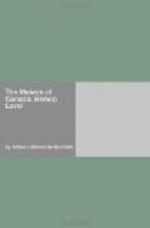The church of Notre-Dame de Bonsecours was twice remodelled; built at first of oak on stone foundations, it was rebuilt of stone and consumed in 1754 in a conflagration which destroyed a part of the town. In 1772 the chapel was rebuilt as it exists now, one hundred and two feet long by forty-six wide.
CHAPTER XIII
LAVAL RETURNS TO CANADA
Mgr. de Laval was still in France when the edict of May, 1679, appeared, decreeing on the suggestion of Frontenac, that the tithe should be paid only to “each of the parish priests within the extent of his parish where he is established in perpetuity in the stead of the removable priest who previously administered it.” The ideas of the Count de Frontenac were thus victorious, and the king retracted his first decision. He had in his original decree establishing the Seminary of Quebec, granted the bishop and his successors “the right of recalling and displacing the priests by them delegated to the parishes to exercise therein parochial functions.” Laval on his return to Canada conformed without murmur to the king’s decision; he worked, together with the governor and commissioner, at drawing up the plan of the parishes to be established, and sent his vicar-general to install the priests who were appointed to the different livings. He desired to inspire his whole clergy with the disinterestedness which he had always evinced, for not only did he recommend his priests “to content themselves with the simplest living, and with the bare necessaries of their support,” but besides, agreeing with the governor and the commissioner, he estimated that an annual sum of five hundred livres merely, that is to say, about three hundred dollars of our present money, was sufficient for the lodging and maintenance of a priest. This was more than modest, and yet, without a very considerable extension, there was no parish capable of supplying the needs of its priest. There was indeed, it is true, an article of the edict specifying that in case of the tithe being insufficient, the necessary supplement should be fixed by the council and furnished by the seigneur of the place and by the inhabitants; but this manner of aiding the priests who were reduced to a bare competence was not practical, as was soon evident. Another article gave the title of patron to any seigneur who should erect a religious edifice; this article was just as fantastic, “for,” wrote Commissioner Duchesneau, “there is no private person in this country who is in a position to build churches of any kind.”




